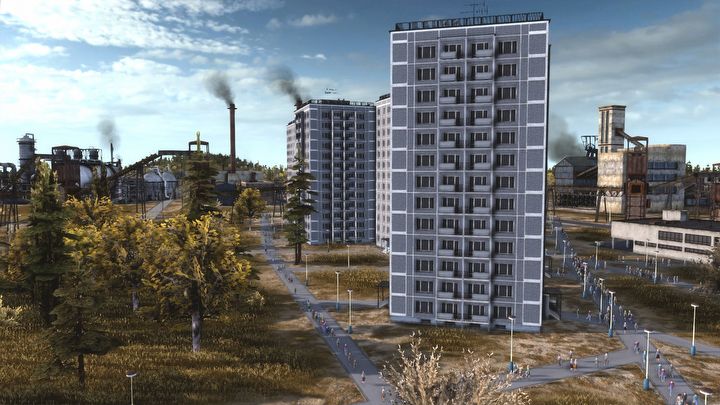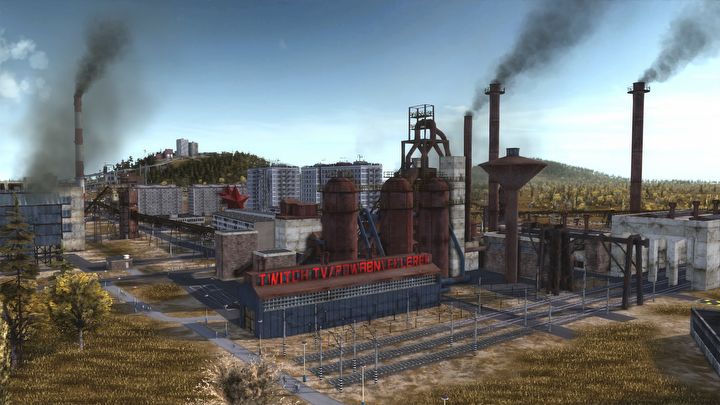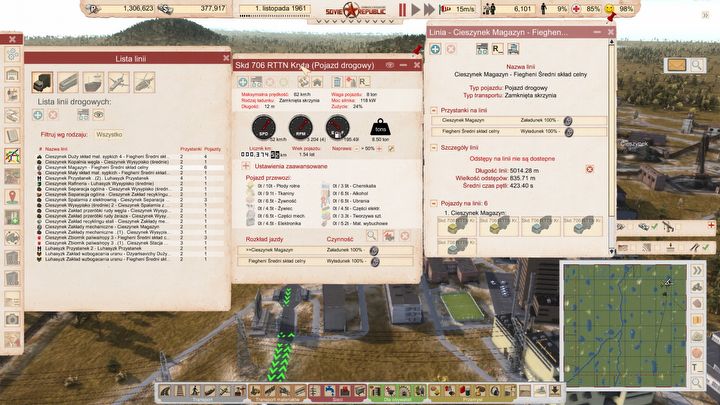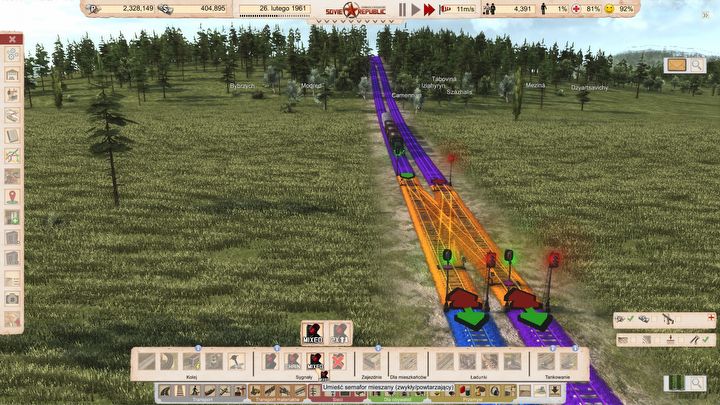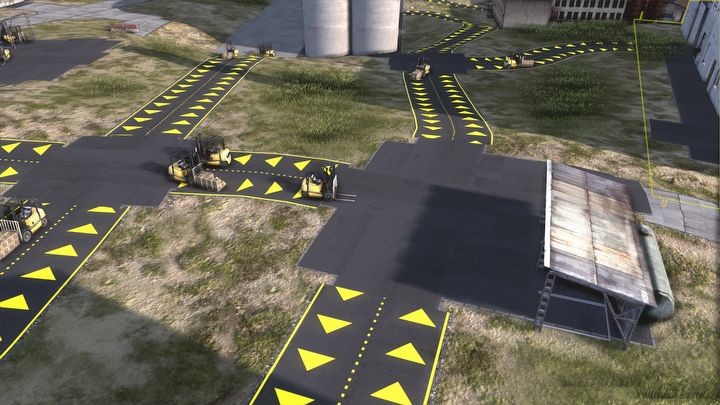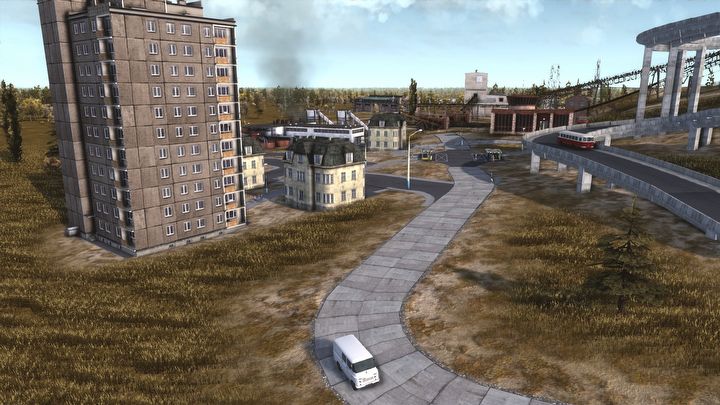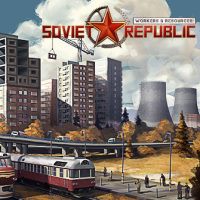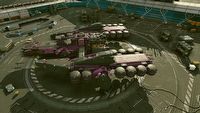Workers & Resources Delivers What Cities 2 Fails, And It's Not Communism
It's a game at first glance as coarse as the times it depicts. Muddy and polluted by heavy industry, with rather unsophisticated graphics. However, underneath this mask lie powerful mechanics that should be the envy of top city builders.
2
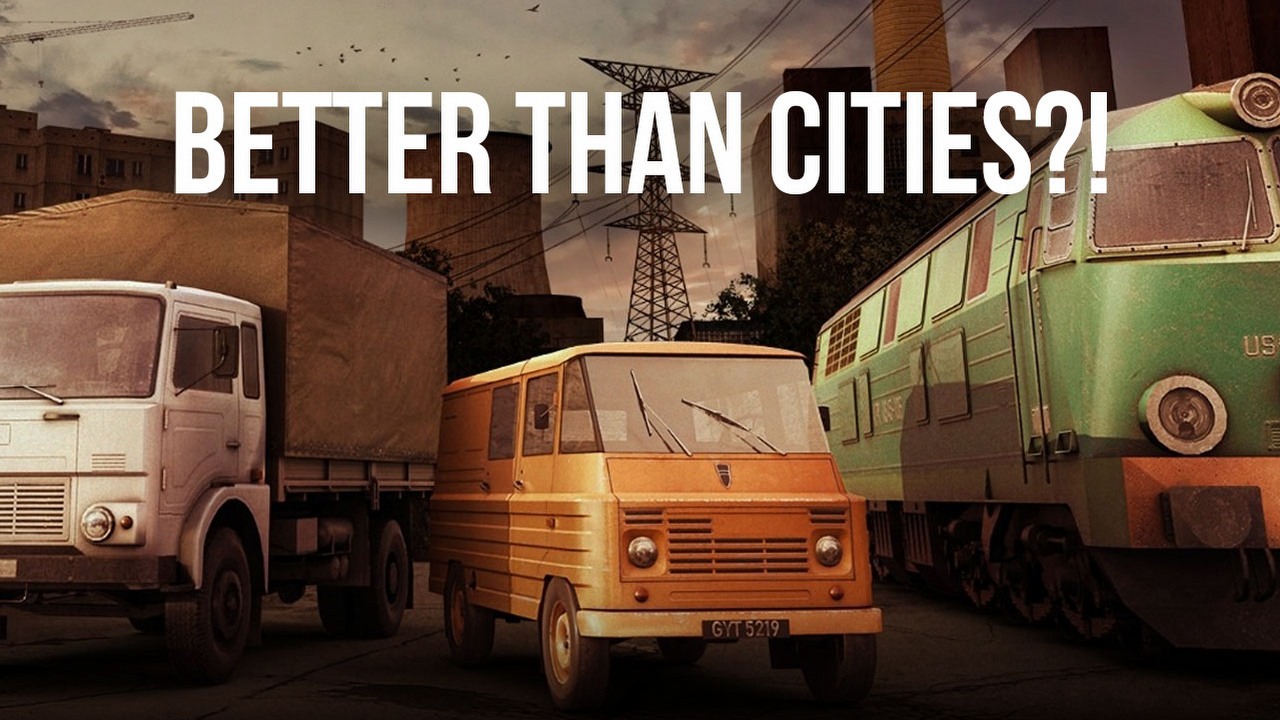
Dull residential blocks in various shades of gray and gloom give way to the smoking chimneys of local factories, which residents commute to daily on identical, dreary buses. If they're lucky, they can buy a car -- one three available models. The whole thing paints a dystopian vision of a city that could easily end up on postcards celebrating the end of the world, or at least civilization. This is the reality of Work... oh, wait. This is a city from Cities: Skylines 2.
In Workers & Resources: Soviet Republic the landscape is, ironically, much more diverse. Although it's a city builder in which we create sad industrial cities of the 60s and 70s, somewhere in a socialist country, we have access to a much wider catalog of buildings and vehicles than in Cities: Skylines 2, in which we build fancy modern metropolises. But this is not the main thrust of this title. What's so engrossing is the absurd level of detail and such level of micromanagement that makes fans of complex games from this genre thrilled. It's a great counterbalance to the overly simplistic and bland Cities: Skylines 2 -- Here we will test our skills in spatial planning, managing production chains and controlling the lives of citizens.
Workers & Resources: Soviet Republic is a game by a small Slovak studio, currently available in Early Access, although everything seems to be heading towards a final release in 2024. At the time of writing this text, nearly 14 thousand players have rated this title on Steam -- 92% positively.
Several years of development were hardly calm, there were plenty of dramatic twists and even a momentary removal of the game from Steam. At this point, however, it's already a refined product that will provide fans with hundreds of hours of entertainment, and a quite large collection of mods will surely add some more. There are Polish goodies like buildings or vehicles that we can associate with our reality.
I questioned the convention, gasped over the graphics. I was wrong
Let's explain why I'm even writing about this game. Workers & Resources: Soviet Republic isn't a new game, but I have been avoiding it for a very long time. The convention of building a socialist city repelled me; it reminded me of junky sims, which prey on nostalgia without offering anything significant. My friends recommended this game to me, but as if to spite them, I insisted on ignoring its existence for some time. On the one hand, I do not feel very inclined to miss the old days, but on the other, I am old enough to remember them.
After the botched release of Cities: Skylines 2, I felt very disheartened and was looking for a city builder that would be more than just a simulator of watching our account balance grow. And again, everyone started recommending Workers & Resources to me. It wasn't until I had a nuclear power plant, a space program, and 300 million in the bank in my city in Cities: Skylines 2, that I realized I could solve the traffic problem by buying each resident a private jet. I installed the game and it just sucked me in. Socialism has consumed me.
Excuse me, sir, how often do you think about socialism?
Looking for an analogy, the relationship between Workers & Resources and Cities reminds me of the situation with Pokémon. Games with cute creatures have become infantile, simple, repetitive, and boring in recent years, and I have the same feeling about mainstream city builders. Similarly to Temtem's attempt to push the difficulty level in the opposite direction, this game breaks down every aspect of city management into several additional ones. However, all of this does make sense and forms a logical whole.
What is the gameplay about? It's a pure city builder where we receive a large map that may already contain some structures, or we can choose to start entirely from scratch. It's a real sandbox where there's no plot, only the joy of building and forming production chains. We have the ability (and obligation!) to oversee every aspect of the operation of both the city and individual production facilities, which is justified within the universe itself - after all, a centrally planned economy provides a solid argument for this. The Tropico series also followed a similar pattern, where even the most absurd actions could be rationalized as the whims of a Caribbean dictator.
Wake the hell up, comrade, we have truck to refuel
How detailed is this game? When building a big city, we have control over each vehicle and building. We can order citizens to work in a specific workshop. Alternatively, send a group of trucks to transport a resource to the factory, as we didn't have anything more suitable available at the moment. Each of these tracks has their fuel level, tachometer, speedometer, mileage, and age recorded on their vehicle card. Yes, you can refuel at the station, but the fuel needs to be delivered there first. From the refinery, of course. In contrast, it requires crude oil and produces bituminous mass as a by-product, which can be sold or processed further.
And the garbage, obviously. Every factory and building generates waste that needs to be collected. In strategic factories, it's best to set up a route and assign garbage trucks to ensure that nothing interrupts the production process. Garbage isn't a resource that you can simply throw away and forget. They include a specific combination of products that can and should be reused. So, it's essential to set up factory for scrap recovery, where an incinerator can feed into the power grid or heat homes, and building materials can be transformed into gravel. Do you remember the bituminous mass from the refinery? So by combining it with gravel, you will get asphalt. This one, on the other hand...
Fuel production is actually one of the more straightforward production processes, but it's crucial for everything to work. Let it remain a matter between me and the Party how many times a train or a delivery truck has been stuck in the middle of nowhere because I didn't place the refueling points wisely. In theory, we could construct a contact system immediately and have electric trains, streetcars, and subways running. However, it would be easier and more flexible to rely on diesel vehicles from the beginning.
The developers' approach to food production is the only thing that surprises. There are no guts among them, as the cultivated fields in the complex game of micro-managing the entire region provide... "agricultural produce." It would be desirable to have the ability to decide what and how to cultivate, even in a very simplified manner (grains, vegetables, fruits). So that later it also affects the satisfaction and health of residents. Not to mention a more advanced crop management system, like in Farthest Frontier, where each plant has unique soil requirements. Unfortunately, it doesn't look like it here.
Fortunately, the developers ensured easy adjustment of the difficulty level, making it the greatest strength of Workers & Resources: Soviet Republic through the creation of complex micromanagement mechanics. Many aspects of the system can be deactivated or automated, including water and sewage management, education, police, and so on. It's a good idea to begin with the easiest level and then gradually add more elements as you become familiar with the basics. I spent the first 20-30 hours of the game constantly discovering something new, which sometimes completely disrupted my city management plans - such as facilities responsible for distributing goods from warehouses (yes, I did it manually!) or adorable forklifts.
At first sight, it might appear that the key to success lies in natural resources. By setting up a city close to coal mines, and with a bit of luck and uranium, we will provide an easy and comfortable life for thousands of comrades. In fact, in many city builders, that would be the case, but Workers & Resources: Soviet Republic demands a high level of planning skills - simply building a factory and an accommodation block and connecting them with a road isn't sufficient. We make money from exports, so in order to get paid, we need to transport resources to the appropriate border crossing. In theory, it would be feasible to produce gravel or bricks on a large scale, but the cost of constructing infrastructure, acquiring vehicles, and fuel consumption could outweigh the profits entirely.
Fast-track course in urban planning
Workers & Resources makes a strong case for the power of human feet, even though there's no obstacle to connecting distant settlements and factories with trains or buses. Pedestrians don't need fuel, don't cause traffic jams, and don't lose time commuting on public transportation. We soon find out that it's advantageous to construct accommodation blocks in close proximity to large industrial factories. Placing shops, schools, and kindergartens, as well as a clinic or hospital, near a larger concentration of people, preferably in its center, will further enhance efficiency. Yes, to ensure that everything is within walking distance and forms a small, self-sustaining neighborhood (in terms of daily needs). Congratulations, we have just reconstructed the basics of spatial planning.
Building a well-thought-out housing estate can be challenging. It's necessary to be cautious about the area, tailor it to the needs of the local workplace, and ensure that there are no issues with the delivery of goods and waste disposal. A park, a fountain, and activities for children would be a welcome addition. Perhaps there will be room for a cultural institution as well? We can also walk the dark, modern path and create real concrete jungles lacking in space and basic services. Nevertheless, this will have its repercussions.
This game stands out from other city builders because of the feeling of responsibility and agency it provides (I'm looking at you, Cities: Skylines 2). There's no hidden, simplified mechanism for teleporting citizens to work. Neither good magically turning into money at the factory exit. There are also no simplified budget overviews where some items appear to be randomly generated.
Game provided nostalgia, mods - familiarness
Taking us beyond the Iron Curtain of the second half of the 20th century, the game naturally brings about a sense of nostalgia in slightly older players, while younger ones might be intrigued by the harsh yet pleasantly simpler reality. Mods are the cherry on top, adding many familiar cars, wagons, or buildings from eastern settings. With them, the gameplay is even more realistic and has new features added, and after 30 hours, seeing A»uk and Nysa passing each other on the road right next to a parked Trabant still brings a wide smile. In most games, you cannot see Communist vehicles in action, but Workers & Resources successfully solves this problem.
Currently in the Steam Workshop, there are several thousand mods available, with the two most popular categories being "buildings" and "vehicles" (both completely new models or reskins and new paint jobs for those already in the game). It is clear that the game managed to capture its share of the market and the result are numerous fan projects. Next to minor modifications, you will also find works of considerable size, adding for example a dozen variants of Maluch from its entire production period.
Perfect city builder may never happen, hope lies in smaller games
Is Workers & Resources: Soviet Republic a product without flaws? No, at this stage of development, it is quite far from such a status. The main shortcomings are the somewhat clumsy, overloaded interface (although - let's be honest - it fits perfectly into the convention) and the varying depth of the gameplay. There are areas and elements that literally brim with content, while others have to make do with a smaller scope.
However, let's look at the technical side of this title. It has very low hardware requirements and even weaker computers should have no problems achieving 200% quota, becoming worthy of the title of the hero of Communism. In terms of simulation detail, we have pure madness, and the best example of this are vehicles with monitored mileage, fuel status or even engine rotation. And although the scale of the entire project seems smaller and a pace slower than Cities: Skylines 2 , the gameplay is so skillfully conducted that you get the impression of experiencing a virtually complete simulation of the entire region, taking into account even the smallest details. Possible? Possible. And you don't need a computer that costs as much as a car for the game to run at 60 frames.
Workers & Resources: Soviet Republic is one of numerous independent productions that are taking the builder genre by storm. And it is in great company with titles such as Against the Storm or Timberborn, the beautiful Farthest Frontier, the addictive Foundation or the highly promising Manor Lords .
Does city builders have to be AAA games to reach their full potential? I dare to doubt. Smaller games reach such heights that to waste time on expensive flops that are the result of corporate calculations on how to extract as much money as possible by selling a product that the more ambitious smaller studios wouldn't release even in early access.
And now excuse me, comrades, but I have a Trabant to refuel.
2

Author: Konrad Sarzynski
He has enjoyed writing since childhood and always dreamed of writing his own book. He just never expected it to be a scientific monograph. He has PhD in urban studies, which he is happy to brag about to his friends at every possible opportunity. He started his adventure with Webedia in late 2020 in the Tech department. He created texts, ran the technology newsroom, and later co-founded Futurebeat.pl, being responsible for featured articles and hardware tests. Now he focuses on all kinds of builders - both mainstream and indie - which he streams on his Twitch channel. He lives with his cat and wife.
Latest News
- The hidden details behind V and David’s very different downfalls in Cyberpunk 2077 and Edgerunners
- „They're a bit outdated.” Baldur's Gate 3 director warns those who want to „prepare” for Divinity by playing older installments
- „It's an unimaginable loss.” Gaming industry reacts to the death of Vince Zampella, one of the fathers of modern first-person shooters
- Fallout 3 was described as „Oblivion with guns” and the studio decided to bet on this instead of fighting it
- 2 historic Fallout games available on Amazon Prime Gaming
